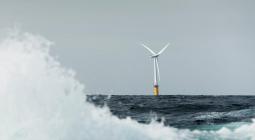UK floating wind 'worth £33.6bn by 2050'.

The floating offshore wind sector in the UK can deliver almost £34bn in economic benefits by 2050, according to a new report by RenewableUK and Scottish Renewables.
The report – 'Floating Wind: The UK Industry Ambition' – says that the technology is necessary for the UK to reach its legally-binding net zero carbon emissions target by 2050 and to fulfil Scotland’s commitment to achieve this by 2045.
The industry estimates that floating wind can support 17,000 UK jobs by 2050, particularly in coastal communities in England, Scotland and Wales.
Economic benefits represent a return of £15 for each £1 invested in early stage support, the report said.
It added that the UK is in a unique position, given its global lead, to export floating wind worldwide to emerging markets with deep-water coastlines, such as China, Japan, Norway, Portugal, South Korea, Spain, Taiwan and the US.
The export market is expected to be worth at least £230m a year by 2031 to UK exporters, R-UK and Scottish Renewables said.
The study suggests that the UK government should use the contracts for difference auction framework to create a specific pot of funding for innovative technologies, such as floating wind.
“This will secure an increase in new capacity from 32MW now to up to 2GW by 2030, making floating wind cost-competitive by that date,” the trade bodies said.
The report also calls for potential sites to be made available all around the UK, and for government and industry to invest jointly in new infrastructure supporting the development of floating wind at part of the UK’s Industrial Strategy.
“A clear pipeline of commercial-scale projects will bring about cost reduction through economies of scale,” it said, adding that the ScotWind leasing process provides an opportunity for the development of floating wind in Scottish waters.
R-UK head of policy and regulation Rebecca Williams said: “The renewable energy sector has built its success on delivering innovation; floating wind is a prime example of what we can achieve.
“Our vision is to do much more at scale, securing further cost reduction and much-needed new capacity.
“As we build even further out to sea into deeper waters, floating wind will unlock new areas for us to make use of our state of the art technology.
“We want to work with government to maximise the extraordinary opportunities offered by this cutting-edge technology in which the UK leads the world.”
Scottish Renewables director of policy Morag Watson said: “Scotland’s offshore energy experience and our deep water wind resource means we’re already a world leader in floating wind – technology which will be necessary to meet our net-zero emissions target and offers the most cost-effective pathway to delivering more than 50GW of offshore wind in UK waters.
“This publication sets out how government, working with industry, as agreed in the Offshore Wind Sector Deal, can identify and deliver joint investments in the infrastructure which will underpin the development of floating wind and its supply chain, supporting the development of the UK Industrial Strategy.”
Overall, the UK has the potential to install 75GW of offshore wind capacity – including floating wind – by 2050, up from 8.5GW now to reach net zero by the most cost-effective pathway, the report said.
31 October 2019
reNEWS.BIZ




